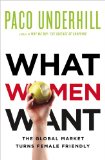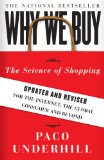This is the continuation of a post about how men and women shop, in anticipation of Paco Underhill's upcoming book What Women Want and the mobile shopping app we're developing. Quotes below are from his first book, Why We Buy.
How men and women shop in most stores
First, "shopping is still and always will be meant mostly for females." So you've got to expect stores to be geared mainly toward women.For example, the neighborhood hardware store was essentially killed by do-it-yourself stores like Home Depot and Restoration Hardware because women felt unwelcome in old-fashioned hardware stores. At these new stores, which are either warehouses or lifestyle shops, a woman can look at -- that is, shop for -- beautifully displayed paint colors, floor tiles, and drawer pulls. Hardware is now less about the nuts and bolts and more about the colors and textures of decoration.

Next, some basic gender comparisons: More women than men look at price tags (86% vs. 72%), perhaps reflecting a deeper consideration of value as compared to time spent shopping. In supermarkets, almost all women have shopping lists, while less than 25% of men do. Both of these tendencies mean that men are more easily upgraded, and more suggestible, than women.
In general, when you're a woman, you see purchases as things that will "turn you into other, idealized versions of yourself: That dress makes you beautiful..." So when a woman asks if these jeans look good on her, it's a question of self-actualization, not just a simple fashion decision. Men, on the other hand, tend to see items as simply things to use or wear, not as extensions of themselves.
While many women shop as a pastime (sometimes called retail therapy or done with friends), it's often "crammed into the tight spaces between job and commute and home life and sleep." As a result, women are becoming more like men: "hurried hit-and-run artists instead of dedicated browsers and searchers." Stores, then, have to put more thought into making it easy for everyone to find what they want.

Because stores are mostly geared toward women, we shouldn't be surprised that men often feel uncomfortable in shops. If you're a man, you still tend to see yourself as a provider: "The man almost always pays" for the items he and his family pick out. Buying things, including extravagant things, for others in their family may fulfill an important part of men's self-image.
Husbands often influence their wives to spend less time in stores (Can we go home now?). The woman then spends less, to the store's dismay. To give men something to do in a home-goods store, for example, Underhill suggests that the retailer group all the barware in one male-friendly area. That way, husbands will have something to look at, and maybe even buy, while their wife shops. After all, many men actually enjoy buying beer and junk food, so why not sell them the tableware to put their drinks and snacks in?
Looking ahead
Underhill pointed out that nearly the entire retail sales system has adapted itself to sell to women, so trends in how women shop will have a major effect on stores in the future. With women becoming more like men in their shopping habits, I'm eager to read What Women Want to see how Underhill thinks shopping will evolve in the future.



RT @WhiteGloveApps New blog post: Women Shop and Men Buy: Gender Differences in Shopping Part 2 http://bit.ly/9q3TsT
This comment was originally posted on Twitter